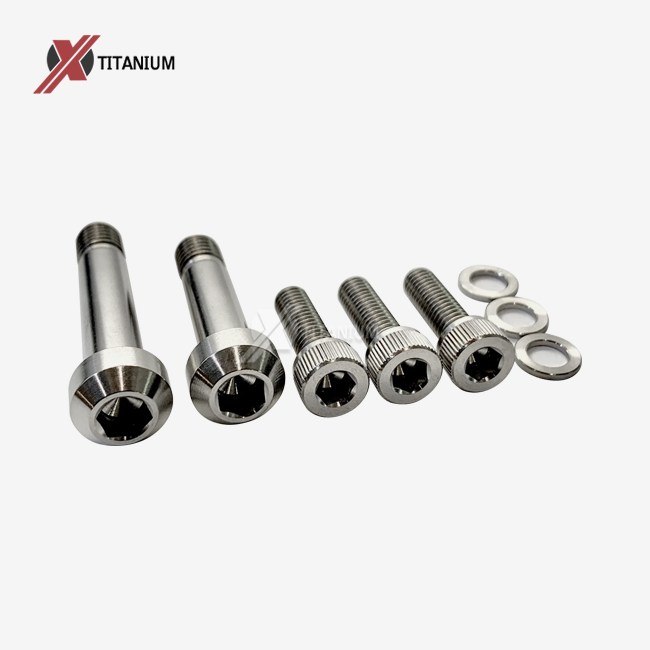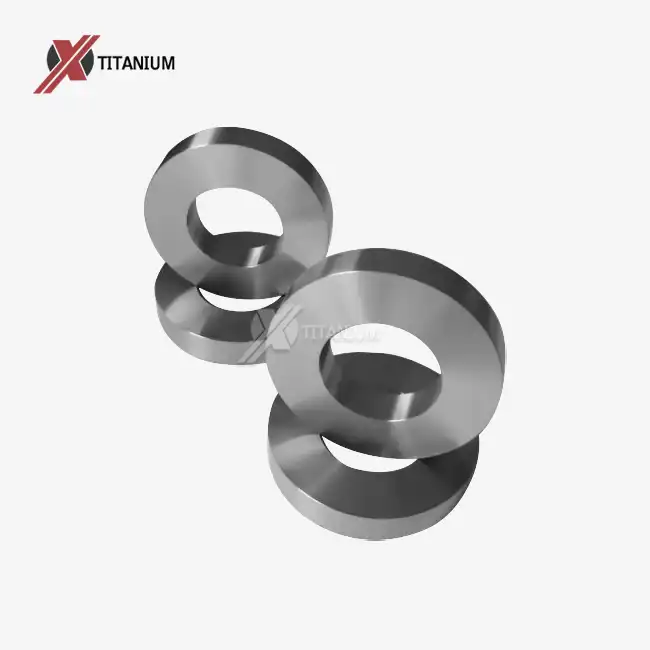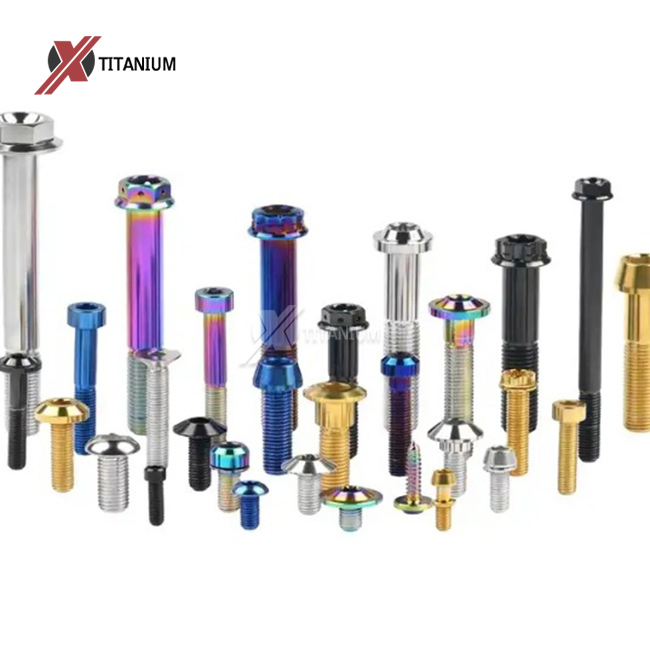Understanding Titanium Mountain Bike Bolts
Properties of Titanium Bolts
Titanium mountain bike bolts possess a unique set of properties that make them ideal for high-performance cycling applications. These bolts are crafted from Grade 5 titanium alloy (Ti-6Al-4V), which offers an optimal balance of strength, weight, and corrosion resistance. The alloy's composition includes 6% aluminum and 4% vanadium, enhancing its mechanical properties.
One of the most significant advantages of titanium bolts is their exceptional strength-to-weight ratio. They provide comparable strength to steel bolts while being approximately 45% lighter. This weight reduction can make a noticeable difference in a bike's overall performance, especially in competitive settings where every gram counts.
Corrosion resistance is another hallmark of titanium bolts. They naturally form a protective oxide layer when exposed to air, making them highly resistant to rust and corrosion. This feature is particularly beneficial for mountain bikes that are frequently exposed to harsh environmental conditions, including moisture, mud, and varying temperatures.
Manufacturing Process
The production of high-quality titanium mountain bike bolts involves a precise and controlled manufacturing process. These bolts are typically created through CNC machining, which allows for exceptional accuracy and consistency in their dimensions and thread patterns.
The process begins with high-grade titanium alloy stock, which is carefully selected to ensure optimal material properties. The stock is then fed into advanced CNC machines that meticulously shape the bolts according to precise specifications. This includes cutting the threads, forming the bolt head, and ensuring proper tolerances are maintained throughout the bolt's length.
After machining, the bolts undergo a series of quality control checks to verify their dimensional accuracy and surface finish. Many manufacturers also employ advanced testing methods, such as ultrasonic inspection, to detect any internal flaws or inconsistencies in the material.
Comparison with Other Materials
When comparing titanium mountain bike bolts to those made from other materials, several key differences become apparent. Steel bolts, while strong and cost-effective, are significantly heavier than their titanium counterparts. This added weight can impact the overall performance of a high-end mountain bike, particularly in racing scenarios.
Aluminum bolts offer a lightweight alternative but generally lack the strength and durability of titanium. They are more prone to stripping and may require more frequent replacement, especially in high-stress applications.
Stainless steel bolts provide good corrosion resistance but still fall short of titanium in terms of weight and overall performance. They are often used as a middle-ground option, balancing cost with durability.
Titanium bolts excel in combining the best attributes of these materials. They offer the strength of steel, the lightweight nature of aluminum, and surpass stainless steel in corrosion resistance. This unique combination of properties makes titanium bolts a premium choice for discerning mountain bikers who demand the highest level of performance from every component on their bike.
Factors Affecting Bolt Stripping
Material Composition and Hardness
The material composition and hardness of titanium mountain bike bolts play a crucial role in their resistance to stripping. Grade 5 titanium alloy, commonly used in these bolts, offers an optimal balance of strength and ductility. This composition allows the bolts to withstand high torque loads without deforming or stripping.
The hardness of titanium bolts, typically ranging from 36 to 39 on the Rockwell C scale, contributes to their durability. This level of hardness provides excellent wear resistance while still allowing for some flexibility to absorb shock and vibration. The combination of material strength and appropriate hardness significantly reduces the likelihood of stripping, even under demanding mountain biking conditions.
Thread Design and Quality
The design and quality of the threads on titanium mountain bike bolts are critical factors in preventing stripping. High-quality titanium bolts feature precision-cut threads with optimal pitch and depth. This ensures a snug fit and even distribution of forces when the bolt is tightened.
Many titanium bolts utilize a rolled thread design rather than cut threads. Rolled threads are formed by compressing the titanium, which results in a stronger, more uniform thread pattern. This process also work-hardens the surface of the threads, further enhancing their resistance to wear and stripping.
The thread profile is another important consideration. Titanium bolts often feature a slightly rounded thread profile, which helps to reduce stress concentration points and minimize the risk of thread damage or stripping during repeated tightening and loosening cycles.
Installation Techniques
Proper installation techniques are paramount in preventing the stripping of titanium mountain bike bolts. Using the correct tools and following manufacturer-recommended torque specifications are essential steps in ensuring the longevity and performance of these premium components.
When installing titanium bolts, it's crucial to use a high-quality torque wrench calibrated for the specific torque range required. Over-tightening is a common cause of bolt stripping, and titanium's unique properties mean that it requires different torque settings compared to steel or aluminum bolts.
Applying a thin layer of anti-seize compound to the bolt threads can help prevent galling, a form of wear caused by adhesion between sliding surfaces. This is particularly important when titanium bolts are used with other metal components, as titanium has a tendency to gall when in contact with certain materials.
Regular inspection and maintenance of titanium bolts are also crucial. Periodically checking and re-torquing bolts (to the correct specifications) can help prevent loosening and reduce the risk of stripping due to movement or vibration during use.
Maximizing the Lifespan of Titanium Mountain Bike Bolts
Proper Maintenance Practices
To maximize the lifespan of titanium mountain bike bolts and prevent stripping, implementing proper maintenance practices is essential. Regular cleaning and inspection of bolts should be part of every mountain biker's routine. After rides, especially in muddy or wet conditions, thoroughly clean the bike, paying special attention to all bolt areas.
Periodically remove the bolts and clean both the bolts and the threaded holes. This prevents the accumulation of dirt and grime that can lead to increased wear or difficulty in removing the bolts in the future. When reinstalling, apply a thin layer of titanium-specific anti-seize compound to prevent galling and ensure smooth tightening and removal.
It's also important to regularly check the torque on all titanium bolts. Even high-quality bolts can loosen over time due to vibration and stress. Use a calibrated torque wrench to ensure bolts are tightened to the manufacturer's specifications. Avoid over-tightening, as this can lead to stripping or damage to both the bolt and the component it's securing.
Using Appropriate Tools and Techniques
The use of appropriate tools and techniques is crucial when working with titanium mountain bike bolts. Always use high-quality hex keys or Torx drivers that fit snugly in the bolt head. Loose-fitting or worn tools can lead to rounding of the bolt head, making it difficult to remove and increasing the risk of stripping.
When tightening or loosening titanium bolts, apply steady, even pressure. Avoid using excessive force or jerky movements that can cause the tool to slip. If a bolt seems unusually tight, investigate the cause rather than applying more force, which could lead to stripping. For critical or hard-to-reach bolts, consider using a torque limiting tool. These tools are designed to prevent over-tightening by releasing at a preset torque value, ensuring consistent and safe tightening of titanium bolts.
Addressing Common Issues
Even with proper care, issues with titanium mountain bike bolts can occasionally arise. One common problem is galling, where the titanium bolt begins to seize in the threaded hole. If this occurs, don't force the bolt. Instead, apply a penetrating oil and allow it to soak before attempting to remove the bolt again. If a titanium bolt becomes slightly rounded or damaged, it may be possible to salvage it using a bolt extractor tool. However, it's often safer to replace a damaged bolt entirely to ensure the integrity of your bike's components.
In cases where a titanium bolt has become completely stripped, specialized extraction tools may be necessary. It's often best to seek the assistance of a professional bike mechanic in these situations to avoid further damage to your bike. By following these maintenance practices, using appropriate tools, and addressing issues promptly, you can significantly extend the lifespan of your titanium mountain bike bolts and maintain the optimal performance of your bike.
Conclusion
Titanium mountain bike bolts offer exceptional performance and durability, making them a premium choice for serious cyclists. Their resistance to stripping, when properly installed and maintained, is a key advantage over other materials. By understanding the unique properties of titanium bolts and following best practices for installation and maintenance, riders can ensure these high-quality components provide long-lasting reliability and performance.
For those seeking top-tier titanium mountain bike bolts and expert advice on their use, Baoji Chuanglian New Metal Material Co., Ltd. offers a wide range of high-quality titanium products. With over a decade of experience in titanium manufacturing and research, they provide solutions tailored to the demanding needs of mountain biking enthusiasts. For more information or to discuss your specific requirements, please contact them at info@cltifastener.com or djy6580@aliyun.com.


_1747364744942.webp)

